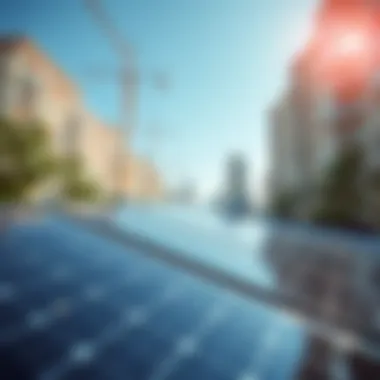Exploring Sustainable Energy Brands: Innovations and Impact


Intro
In recent years, the conversation around energy has shifted dramatically, illuminating the pressing need for a more sustainable approach to satisfy our insatiable demand. This shift isn't just about adopting new technologies; it encompasses a fundamental transformation in how we perceive our relationship with energy production and consumption. With the specter of climate change looming ever large, sustainable energy brands are stepping onto the stage as pivotal players, showcasing their innovative solutions and practices.
While some companies merely dip their toes into the green waters, others are diving in headfirst, crafting representational changes that bolster both environmental integrity and economic viability. The purpose of this article is to pull back the curtain on these noteworthy brands and examine their innovations, the impact they have on the industry, and the ways in which policymakers and consumers alike are becoming vital cogs in this shifting machine.
In the following sections, we will break down key terms in the realm of sustainable energy, move onto expert advice from industry veterans, and ultimately synthesize the insights gathered from the analysis. Each layer will serve to deepen the reader's understanding of not merely how the industry operates, but why it matters in the larger scheme of our collective future.
Understanding Sustainable Energy
Understanding sustainable energy is at the heart of contemporary discussions around energy production and consumption. As global challenges mount—such as climate change, resource depletion, and energy insecurity—the need for sustainable solutions becomes increasingly apparent. Sustainable energy isn’t just a buzzword; it encompasses a wide range of practices, technologies, and philosophies that seek to meet the energy needs of the present without compromising the future.
Definition and Importance
Sustainable energy refers to energy systems that can deliver power without depleting natural resources or causing significant harm to the environment. This can include a variety of energy sources like solar, wind, geothermal, and biomass, which, unlike fossil fuels, can be replenished naturally. The importance of sustainable energy lies not only in mitigating the effects of global warming but also in fostering economic growth and enhancing energy security.
- Environmental Benefits: Reduction in greenhouse gas emissions is a core advantage. By shifting away from coal and oil, we minimize pollution that harms air quality and contributes to climate change.
- Economic Resilience: Investing in renewable energy creates jobs and stimulates local economies. As seen in places like Denmark, a robust wind energy sector can provide thousands of jobs and economic stability.
- Energy Independence: Relying on renewable sources diminishes dependence on imported fuels, a critical factor for many nations seeking to enhance their energy sovereignty.
Moreover, sustainable energy presents an opportunity for innovation. The ongoing advancements in technology mean that the potential for efficiency and cost-effectiveness is rapidly evolving. Organizations and governments around the world are investing heavily in these technologies, recognizing that the first to adopt and innovate will likely lead in the future energy landscape.
The Global Shift Towards Sustainability
The global shift towards sustainability involves acknowledging the consequences of traditional energy practices and actively choosing alternative pathways. In many urban areas, the air quality has drastically improved as cities transition to clean energy solutions. Additionally, renewable energy has gone from a niche market to a foundational component of national energy strategies.
Countries like Germany and Spain are paving the way with comprehensive renewable policies and grid integration strategies that focus on efficiency. This trend demonstrates a collective recognition that our current energy systems are unsustainable in the long term. The rise of sustainable brands in the energy sector is a direct response to consumer demand for cleaner options.
"The true costs of energy are much greater than we often account for; sustainability is no longer just an ethical choice—it's an economic necessity."
In summary, understanding sustainable energy is crucial for tackling the pressing issues of this century. Its relevance spans environmental, economic, and social dimensions, making it a multi-faceted approach essential for a sustainable future.
Key Sustainable Energy Brands
The landscape of sustainable energy is rapidly evolving, revealing a range of innovative brands that play a crucial role in promoting green energy solutions. Not only do these brands help to combat the growing environmental crisis, but they also provide economic opportunities. In an era where fossil fuels dominate energy production, sustainable brands offer a viable alternative that aligns with both environmental and financial sustainability. The significance of these brands cannot be overstated; they serve as a beacon for innovation and responsible consumption.
Overview of Major Players
When we think about key players in the sustainable energy sector, several names come to mind. Companies like Tesla, known for its electric vehicles and battery technologies, stand out as a leader not just in automotive innovation but in transforming energy consumption as a whole. Their battery technology helps stabilize the grid and make renewable energy sources more reliable.
Another giant worth mentioning is NextEra Energy. They aren't just playing the game; they're changing the scoreboard with their massive investments in wind and solar energy. In fact, they have become one of the largest producers of wind and solar energy in the world. This shows that profitability and sustainability can indeed go hand in hand, providing an enticing case for investors.
Moreover, brands like Vestas are crucial in driving the wind energy market, producing wind turbines that harness natural forces to generate clean electricity. These companies highlight the broad spectrum of options available within the sustainable energy market.
"The way forward is not paved with fossil fuels but rather with the renewable sources that our earth has to offer."
Each of these major players is essential in their own right. They draw the attention of financial enthusiasts and individual investors alike, making compelling cases for the transition towards a sustainable energy future. Investors need to look at these companies not merely as brands, but as key components of an overarching shift in global energy solutions.
Innovations in Renewable Energy
The innovations that are brewing within the sustainable energy sector are both revolutionary and practical. For instance, advanced solar panel technology has improved efficiency rates significantly in the past decade. Companies like SunPower have introduced panels that capture sunlight more effectively, providing more energy per square foot than traditional panels. This innovation is particularly beneficial for consumers with limited installation space, as it maximizes output without necessitating an expansive array.
Hydrogen fuel technology is another breakthrough that is making waves. Firms like Plug Power are pioneering the use of hydrogen fuel cells to power everything from forklifts to entire cities. This technology not only presents a clean energy alternative but also paves the way for investments in hydrogen economy infrastructures.
On the wind energy front, there have been commendable advancements in blade design and turbine efficiency. Companies like General Electric have developed wind turbines equipped with larger blades that can generate more electricity in lower wind conditions. As these technologies advance, they not only lower costs but also enhance the reliability of renewable energy sources.
In summary, the innovations in renewable energy are not just enhancing operational capacity; they are redefining the future landscape of energy production. For financial enthusiasts interested in investing in sustainable energy brands, these technological advancements represent opportunities for lucrative returns, provided they're accompanied by ongoing research and regulatory support.
Technologies Driving Sustainable Energy
The landscape of sustainable energy is evolving rapidly, propelled by technological advancements that not only enhance efficiency but also broaden accessibility. Understanding Technologies Driving Sustainable Energy is essential, as these innovations form the backbone of how energy is produced, distributed, and consumed today. The emphasis on reducing environmental impact while ensuring a reliable energy supply has led to an unwavering focus on improving technology in areas like solar, wind, and hydropower.
Innovations in sustainable energy technologies have made them increasingly viable in the face of competition from traditional fossil fuels. These advancements offer numerous benefits, including cost reductions, increased efficiency, and a lower carbon footprint. Furthermore, they position sustainable energy solutions as attractive options for both consumers and investors, paving the way for a greener future. As the climate crisis continues to loom large, the significance of these technologies cannot be overstated.
Solar Power Innovations
Solar power has seen significant innovations over the past few years, changing the game for renewable energy. One noteworthy advancement is bifacial solar panels. They capture sunlight on both sides, increasing energy generation without requiring additional space. Not only does this optimization mean more bang for your buck, but it also efficiently uses the area, making it ideal for urban landscapes where space is often at a premium.
Moreover, floating solar farms have gained traction, particularly in regions with limited land availability. These farms allow for solar panels to be installed on bodies of water, leading to less evaporation and a cooler environment for the panels, which can boost efficiency.
To put it in simpler terms, solar technology is not just about capturing sunlight—it's about using that energy in smarter and more impactful ways. For instance:
- Use of solar skins that blend with roofs, minimizing aesthetic disruption
- Development of energy storage systems that allow excess energy to be stored for evening use
- Integration of smart technology to optimize energy consumption based on real-time data


Wind Energy Technologies
Wind energy technology has also taken leaps and bounds, particularly with the rise of turbine design advancements. Modern turbines are larger and more efficient, capable of harnessing wind energy even at lower wind speeds. Vertical axis wind turbines, for example, offer flexibility in installation and are less threatening to birds, which is a significant ecological concern.
Furthermore, the push for offshore wind farms is opening new horizons. Placing turbines further out to sea minimizes visual impact and usually benefits from stronger winds, which translates to higher energy output.
Key developments include:
- Digital twins in wind farms that use simulations for predictive maintenance, reducing downtime and operational costs.
- Innovative materials such as carbon-fiber blades that are lighter and stronger, further boosting efficiency.
Overall, the technical strides in wind energy exemplify the intricate balance between functionality and environmental consciousness.
Hydropower Developments
Hydropower has long been a stalwart in renewable energy production, but recent developments are breathing new life into this established technology. Small-scale hydropower systems, often referred to as micro-hydro, provide an alternative energy source for rural communities, enabling them to harness local water resources and reduce reliance on grid electricity.
Moreover, advancements in pumped-storage hydropower—which functions like a large battery—allow energy storage by pumping water uphill during low-demand periods and releasing it during peak demand. It’s a clever way of managing energy, creating a reliable supply that balances consumption.
Some pivotal innovations in hydropower include:
- Use of fish-friendly turbines that allow aquatic life to pass through without harm, addressing ecological concerns.
- Transition towards dual-purpose systems that couple energy generation with flood control, combining necessity with energy production.
In summary, these developments illustrate that hydropower remains viable, evolving to meet modern environmental challenges while continuing to provide substantial energy output.
"Innovative technologies in solar, wind, and hydropower are setting the stage for a future where sustainable energy is not just a preference but a fundamental reality."
The remarkable growth in these sectors reflects a broader commitment to a renewable energy agenda that serves both the environment and the economy. As technologies continue to develop, so too will the potential for sustainable energy to transform how we view and use power in our everyday lives.
Further Reading
The Role of Government in Sustainable Energy
The significance of government actions in shaping the sustainable energy sector cannot be overstated. Governments worldwide are increasingly recognizing the crucial role they play in establishing frameworks that encourage the growth of renewable energy sources. By implementing policies that promote sustainability, they can not only enhance environmental outcomes but also stimulate economic growth and innovation. This interplay between government policy and sustainable energy initiatives underscores a vital discussion about the future of energy.
Policies Promoting Renewable Energy
Governments can create an environment conducive to renewable energy development through a variety of policies. This includes establishing clear targets for renewable energy adoption, facilitating research and development, and improving infrastructure. Here are some key areas where policies can make an impact:
- Renewable Portfolio Standards (RPS): These legislations require utility companies to obtain a certain percentage of their energy from renewable sources. Such standards motivate investments in solar, wind, and other green technologies.
- Feed-in Tariffs: This mechanism guarantees a fixed price for energy produced from renewable sources, providing stable financial returns for energy producers, attracting investments to grow the renewable market.
- Carbon Pricing: By internalizing the environmental costs of fossil fuels, carbon pricing creates a financial incentive for companies to transition to cleaner energy sources. This approach can shift market behavior and stimulate the growth of low-carbon technologies.
"Policies serve as the backbone for creating a robust renewable energy sector, shaping investor perceptions and consumer choices."
To illustrate, take Germany's Energiewende strategy that aims for a substantial increase in renewable energy share combined with energy efficiency measures. Its implications are vast as it has spurred job growth and opened doors for innovative green technologies.
Incentives for Sustainable Practices
Incentives play a pivotal role in urging businesses and individuals to embrace sustainable practices. By making it financially attractive to adopt green technologies, governments can significantly stimulate growth in this sector. Some common incentives include:
- Tax Credits: These offer financial relief to consumers and businesses who invest in renewable energy installations. For instance, the Investment Tax Credit (ITC) in the U.S. offers significant tax relief for solar power installations, encouraging widespread adoption.
- Grants and Subsidies: Direct financial support can help reduce the upfront costs associated with renewable energy projects. These funds can be crucial for startups and small businesses venturing into sustainable energy.
- Research Grants: Governments can provide funding for research institutions and private companies focused on developing innovative technologies that can further enhance renewable energy efficiency.
Such incentives not only boost investment but also create a competitive advantage for early adopters in the market.
Moreover, the puzzle of switching to renewable practices is often solved by highlighting the long-term economic benefits. Thus, sustainable energy becomes not just an ethical choice but a financially sound one.
In summary, the government's role in sustainable energy involves crafting policies that foster growth, as well as creating incentives that make sustainable choices appealing. This strategic approach is essential to establish a resilient, innovative, and widely accepted renewable energy landscape. Not just about moving towards a green future, it's a calculated path to economic prosperity.
Consumer Responsibility in Energy Choices
As the global landscape increasingly leans towards sustainability, the role of consumers in making informed energy choices has never been more pivotal. Individuals possess a unique power in shaping the market through their purchasing decisions. When consumers prioritize sustainable energy options, they not only help drive demand but also influence companies to innovate and adopt greener practices.
Making Informed Decisions
Informed decision-making is a cornerstone of responsible energy consumption. What does this entail for the average consumer? It includes evaluating the sources of energy one uses in daily life—be it electricity, heating, or transportation—and understanding their environmental impact.
To make well-rounded choices, consumers can take steps such as:
- Researching Energy Providers: Look into companies that prioritize renewable energy sources, like solar or wind, in their operations. Several entities, such as EnergySage and Green Mountain Energy, offer comparisons of energy providers based on sustainability metrics.
- Checking Certifications: Some labels, like Energy Star or Green Seal, indicate that a product meets strict environmental standards.
- Reading Reviews and Articles: Authentic customer feedback and expert reviews can provide insights on the reputation and practices of companies.
An informed consumer is a powerful consumer, and armed with knowledge, one can influence market trends towards sustainability.
Supporting Sustainable Brands


Choosing to support sustainable brands goes beyond just informed decisions; it is about actively participating in a larger movement towards environmental stewardship. By favoring companies that demonstrate a commitment to sustainability, consumers send a clear message—eco-consciousness is both valued and rewarded.
Here are some effective ways to support sustainable brands:
- Seek Out Local Products: Many local companies prioritize sustainable practices, reducing the carbon footprint associated with transportation.
- Invest in Green Technologies: Consider energy-efficient appliances and devices or even solar panel systems that, although may require higher upfront investment, result in long-term savings and environmental benefits.
- Participate in Advocacy: Engage with grassroots movements or organizations that promote sustainable energy practices. Websites like 350.org provide resources and community support.
"By shifting our purchasing habits, we can reshape the energy landscape and foster companies that prioritize our planet’s wellbeing."
In the end, consumer responsibility in energy choices is not just about making ethical decisions; it's about being part of a collective effort to transform our energy landscape. As individuals embrace this responsibility, the ripple effects can lead to significant advancements in how energy is produced and consumed, securing a more sustainable future for all.
Challenges Facing Sustainable Energy Brands
The landscape of sustainable energy brands is not without its hurdles. As the world grapples with climate change and strives for a greener future, these brands face intricate challenges that could determine their success or failure. Market competition stands fierce, pushing innovation to its limits. Additionally, technological limitations can hinder these brands from efficiently scaling up operations. On top of that, public perception and awareness play a significant role in the overall growth of sustainable energy solutions. Understanding these aspects is pivotal in comprehensively examining the landscape of energy brands.
Market Competition
In an increasingly crowded marketplace, sustainable energy brands compete not only among themselves but also with traditional energy producers. The stakes are high, with consumers and businesses alike evaluating value for money, sustainability, and efficiency when making energy choices. The challenge isn't just about being green; it's about demonstrating it with a clear return on investment. Companies like Tesla have set the bar, making it tough for newcomers to gain a foothold.
Moreover, established oil and gas companies are venturing into renewable sectors. They're leveraging their resources to research and develop sustainable technologies. This dual pressure can stymie smaller brands trying to carve out their niche.
"To survive, sustainable brands must differentiate themselves by showcasing unique innovations and consumer benefits."
Brands that fail to stand out run the risk of being lost amid the noise. Effective branding strategies, advertising, and partnerships can strengthen market position, enabling them to not only compete but thrive.
Technological Limitations
Despite significant innovations, technological limitations continue to haunt sustainable energy brands. Take, for instance, solar energy systems which, while advanced, still grapple with efficiency challenges. The conventional silicon solar cells have a theoretical maximum efficiency of around 29%; surpassing that means delving into more complex technologies like perovskites. Moreover, energy storage remains a significant hurdle. Batteries need reliability and longevity to encourage widespread adoption—but progress is slow.
Companies must navigate a tightrope, balancing costs and technological advancements. This could involve hefty investments in R&D, which may not yield immediate results. The risk here is high; while they strive for breakthroughs, they also face competition from more established players who might adopt new technologies faster.
Public Perception and Awareness
The perception of sustainable energy brands is often marred by skepticism. Many potential customers are unsure about the actual benefits of switching to these products. Concerns may arise regarding the reliability and cost-effectiveness of sustainable solutions, stemming from a lack of understanding. Media coverage can either bolster a brand’s image or tarnish it, often leading to public misconceptions.
Efforts to educate the public can help mitigate these stereotypes. Engaging marketing campaigns that highlight their environmental benefits and reliability can shift public opinion favorably. Transparency around energy sources, production methods, and environmental impact can forge trust between consumers and brands. If public perception is favorable, brands will likely see increased adoption of their sustainable solutions—an essential step for the industry to move forward and genuinely make a difference.
By embracing these challenges head-on, sustainable energy brands can innovate and adapt, providing meaningful contributions to the energy discourse while also ensuring their survival and growth in a competitive market.
Future Trends in Sustainable Energy
The landscape of sustainable energy is marked by rapid evolution. This section aims to spotlight the upcoming trends that could pivot the energy sector towards greener practices. Recognizing these trends isn't just a matter of curiosity; it’s crucial for investors and individuals alike to stay ahead of the curve. Understanding future developments in sustainable energy translates directly into potential financial opportunities and innovations that could reshape our daily lives.
Emerging Technologies
Innovation is at the heart of sustainability. New technologies are emerging that could revolutionize energy generation and consumption. One notable trend is the improvement in energy storage solutions. For instance, companies like Tesla are working on lithium-ion battery technology, promising increased storage capacity and efficiency.
Key technologies to watch include:
- Solid-state batteries: These offer better safety and higher energy density compared to current lithium-ion solutions.
- Green hydrogen production: Utilizing renewable energy sources to produce hydrogen, it could serve as a clean fuel of the future.
- Smart grids: These systems leverage advanced technology to efficiently manage and distribute energy, accommodating renewable sources more effectively.
Investments in such technologies not only drum up the energy output but also help in reducing costs over the long term. It’s anticipated that by 2030, we could see a mainstream adoption of these innovations, making energy more efficient than ever.
Changing Consumer Habits
Consumer preferences are gradually shifting from traditional energy sources to sustainable options. Nowadays, energy users are more informed than ever. They are actively seeking out brands that align with their values, contributing to a booming market for sustainable energy solutions.
Factors influencing these changes include:
- Increased awareness: People are more aware of climate change and its effects, prompting them to seek cleaner options.
- Economic incentives: More governments are providing tax benefits or subsidies for renewable energy usage.
- Social influence: Communities are shaping behaviors; eco-friendly practices become trendy and encourage others to follow suit.
"Consumer choices are not just affecting the market; they are redefining it, creating space for sustainable brands to thrive."
The challenge for businesses now is to keep pace with these evolving preferences while making their sustainable offerings compelling enough to attract consumers. Not only will this push brands to innovate further but will also ensure that transitioning to sustainable energy becomes a part of daily consumer choices.
The convergence of emerging technologies and changing consumer habits heralds a new era in sustainable energy. For investors, this signifies fertile ground for opportunity, particularly in sectors that manage to marry cutting-edge technology with the desires and values of today's consumers. As companies thrive on innovations, they will inevitably lead us towards a more sustainable and economically viable energy future.
Measuring the Impact of Sustainable Brands
Understanding how to assess the influence of sustainable energy brands is crucial in today's world. As consumers become more conscious of their energy choices, and as the global community grapples with climate change, it’s essential to evaluate the success of these brands. Measuring impact isn’t just about numbers; it encompasses environmental benefits, economic contributions, and societal changes that stem from the implementation of sustainable practices.
Environmental Impact Assessments


Environmental Impact Assessments (EIAs) play a vital role in determining the ecological footprint of sustainable energy projects. These assessments are designed to predict how a proposed project will affect the environment before it begins. An EIA considers various factors like air and water quality, biodiversity, and resource management. This foresight helps organizations minimize negative impacts while maximizing positive ones.
For example, when a solar farm is built, an EIA can help in understanding how local wildlife may be disrupted and can suggest mitigation strategies. Moreover, the results from EIAs guide policymakers in creating regulations aimed at protecting ecosystems.
Some key elements of EIAs include:
- Baseline Studies: Understanding the state of the environment before projects begin.
- Impact Prediction: Forecasting potential environmental changes.
- Public Participation: Engaging local communities in the assessment process.
- Mitigation Strategies: Proposing ways to reduce negative effects through design changes or offsets.
"An EIA isn’t just a checklist, but rather a crucial planning tool that promotes sustainable development while ensuring the environment is preserved."
Economic Benefits of Sustainability
Economic considerations are equally important when evaluating the impact of sustainable energy brands. The shift towards sustainability is not just good for the planet; it can also result in significant economic benefits for communities and investors alike. By investing in renewable energy, we create jobs, lower energy costs in the long run, and even boost local economies.
Here are some notable economic impacts:
- Job Creation: Renewable sectors like solar and wind power require a skilled workforce, leading to job opportunities in manufacturing, installation, and maintenance.
- Cost Savings: Due to advancements in technology, the cost of renewable energy systems has decreased significantly. This trend leads towards cheaper electricity for consumers.
- Increased Investment: As sustainable brands emerge, investment in this sector is likely to grow. This can increase the overall market stability, providing a more resilient economy.
- Improved Public Health: By transitioning to cleaner energy, communities can experience fewer health problems related to pollution, leading to reduced healthcare costs.
For further details on environmental assessments and economic implications, you can visit Wikipedia and Britannica respectively.
Case Studies of Successful Sustainable Brands
The anchor to any discussion surrounding sustainable energy brands lies in the success stories that highlight their innovations and adaptability in a changing market. Case studies do more than just serve as stories; they embody the tangible impact these brands have on both the environment and the economy. By examining the journeys of these successful entities, readers can glean insight into best practices, setbacks, and the strategies that have propelled them to the forefront of their industries. This exploration aims to shed light on how specific brands have maneuvered the challenges of sustainability, demonstrating real-world applications that resonate with financial enthusiasts and individual investors alike.
Pioneers in Solar Energy
When we talk about pioneering efforts in solar energy, companies like First Solar and SunPower often spring to mind. These brands have taken significant strides towards not just harnessing solar energy, but optimizing its efficiency and cost-effectiveness, encouraging even the harshest critics to reconsider their stance on solar technologies.
First Solar, headquartered in the United States, has become a heavyweight in the solar panel manufacturing sector. They utilize a unique thin-film technology that reduces material costs significantly while maintaining energy efficiency. Since its inception, the company has focused on sustainability in its manufacturing processes. For example, they have developed a recycling program that ensures that old solar panels are not merely discarded but are reprocessed into new products. This closed-loop model not only minimizes waste but also sets a benchmark for circular economy practices in the sector.
On the other hand, SunPower has differentiated itself by emphasizing high-efficiency solar cells. In 2019, they showcased advancements in solar technology that pushed efficiency rates past 22%, a remarkable feat in the world of solar energy. Their commitment to sustainability is evident not just in product offerings, but also in their corporate practices, such as their goal to be 100% carbon neutral by 2025.
Such advancements in solar energy not only benefit the companies involved, but they also serve the broader community by equipping consumers with options that lead to lower energy costs and reduced carbon footprints. By analyzing these case studies, investors can assess the viability of supporting similar brands alongside understanding sustainable energy dynamics.
Leaders in Wind Energy
Wind energy brands such as Vestas Wind Systems and Siemens Gamesa stand as beacons in the renewable energy landscape. These leading names are not just participants in the race towards a greener future; they are defining the parameters of success in wind technology.
Vestas, a Danish company, has been instrumental in setting global standards for wind turbine efficiency. Their focus on innovation has allowed them to achieve the world's most significant market share in wind turbine production. They often invest heavily in research and development to improve turbine design and functionality, ensuring that their products can withstand extreme weather conditions while maximizing energy generation.
Siemens Gamesa, with its notable turbine technology, is also making waves. Their approach revolves around scalable solutions which can be tailored to fit different geographical needs and energy demands. This flexibility empowers both large utility projects and smaller local installations, proving that wind energy is not a one-size-fits-all scenario. Moreover, their commitment to sustainable business practices is apparent; they aim for their operations to be carbon neutral by 2025, proving their dedication to the overall goal of sustainability.
By delving into these case studies, we uncover how strategic executions can heighten energy productions while lowering environmental impacts. These case studies not only reveal the potential profitability of investing in sustainable energy brands but also appeal to the growing demand for green investments, aligning returns with ethical considerations.
“Investments in renewable energy are not just benign contributions to the economy; they are savvy commitments by forward-thinking investors.”
Sustainable Energy in the Developing World
The significance of sustainable energy in the developing world cannot be overstated. This region faces unique challenges that make the transition to renewable energy not only important but vital for economic development and environmental sustainability. Access to reliable energy is often limited, hindering growth in various sectors including education, healthcare, and agriculture. Moreover, the developing world is disproportionately affected by climate change, having contributed the least to the problem yet suffering the most from its consequences.
Harnessing sustainable energy sources can pave the way for numerous benefits:
- Economic growth: Utilizing renewable sources lowers energy costs over time and creates jobs in sectors such as solar panel manufacturing and installation.
- Enhanced education: With more reliable energy, schools can operate with electric lighting, and students can study in safer environments.
- Healthcare improvements: Hospitals with reliable power can offer better services, including refrigeration for medicines and 24/7 care.
- Environmental protection: Renewable energy reduces reliance on fossil fuels, curbing air pollution and allowing communities to thrive in healthier ecosystems.
However, the journey toward sustainable energy is fraught with challenges that can hinder progress.
Challenges and Opportunities
In the developing world, the path to adopting sustainable energy solutions is littered with both challenges and opportunities:
- Infrastructure limitations: Many regions lack necessary infrastructure to support advanced energy technologies. For instance, rural areas might not have the electric grid infrastructure needed for solar or wind projects.
- Financial constraints: Access to capital is vital for investment in renewable energy projects. Without financial support, even the most innovative ideas may falter.
- Political instability: In some regions, governance issues can create an unpredictable environment, dissuading foreign investment in sustainable energy projects.
- Cultural and social resistance: Changing mindsets can take time, as local communities might be hesitant to shift from traditional energy sources.
Despite these hurdles, opportunities abound:
- Community-based initiatives: Local entrepreneurs and organizations are stepping into the spotlight, showcasing how grassroots movements can effectively implement sustainable energy solutions.
- Technological advancements: Innovations in solar, wind, and bioenergy technologies are making them more accessible and affordable.
- Global support: Organizations such as the United Nations and various non-governmental organizations are working tirelessly to push sustainable energy agendas, providing technical and financial assistance.
"The only thing that can change the future is the courage and conviction of the people fighting for it."
This interplay of challenges and opportunities highlights the necessity for a robust strategy in pursuing sustainable energy. It demands the right partnerships, investments, and innovations.
Local Brands Making a Difference
In the ever-growing quest for sustainable energy, local brands in developing nations are proving that they can lead the charge. These grassroots efforts reflect an understanding of local needs while providing practical solutions:
- M-KOPA Solar: This company offers an affordable pay-as-you-go solar system for off-grid households in East Africa. This model not only provides energy access but also empowers families financially.
- Greenlight Planet: Specializing in solar energy products, this brand enables rural families to shift away from polluting kerosene lamps. Their offerings enhance quality of life through better lighting and energy reliability.
- d.light: Known for its innovative solar-powered products, d.light caters to underserved populations, significantly improving the health and safety of millions who rely on unreliable energy sources.
Through initiatives like these, local brands pave the way for a sustainable future. They demonstrate that investing in renewables is not just possible but fruitful. By creating accessible solutions tailored to the community, they embody the spirit of sustainable development and resilience.















